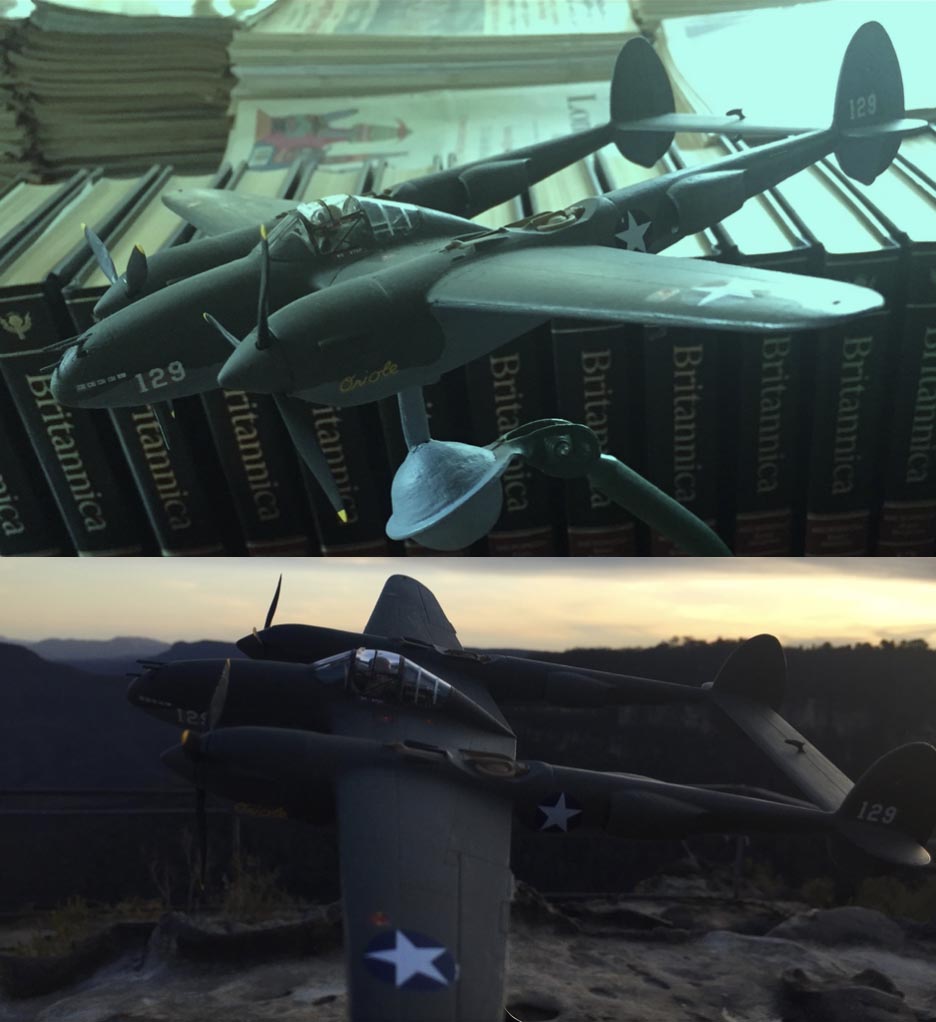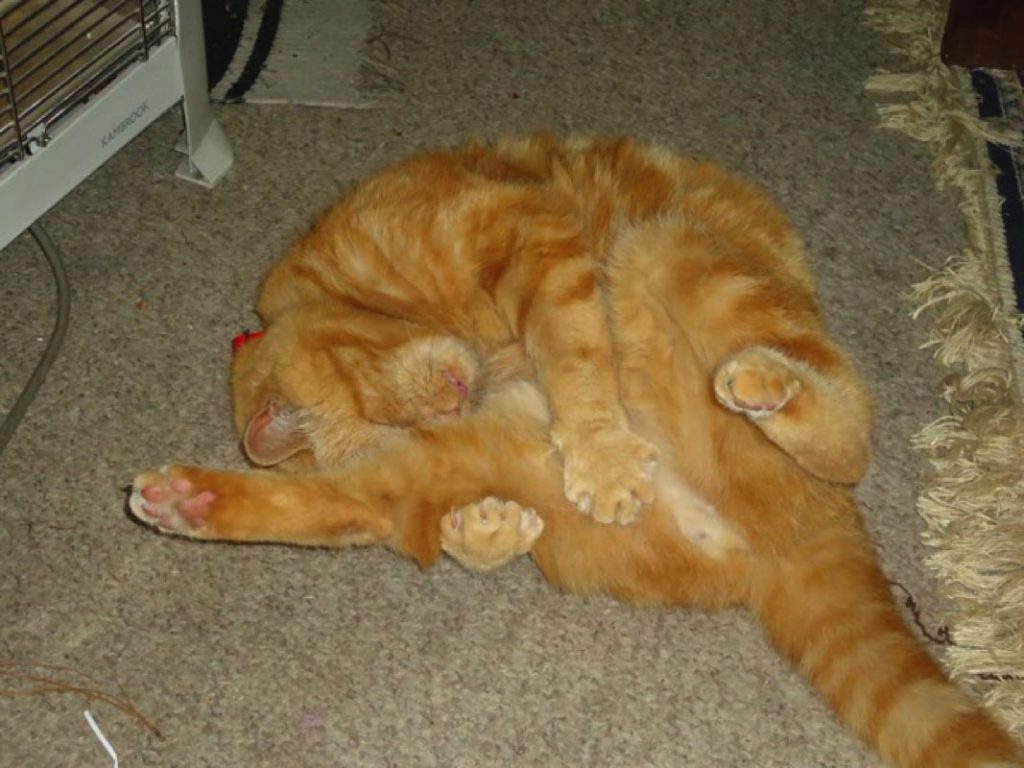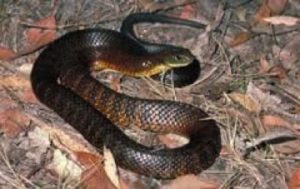Letters from Leura
A CODA FOR ORIOLE
Thursday December 15, 2022You might, in a light-hearted mood, say that when coincidences reign they pour. In March I wrote a story about Oriole Coombe, the young Brisbane woman who, during the Pacific War, had a lethal fighter plane named after her by its pilot, her American Air Corps fiancé. There were remarkable coincidences in my own connection to it: first being led back to a teenage hobby of aircraft model-building and then finding a kit for that very same plane; getting in touch with Oriole’s family and then, most especially, learning she was still alive in the USA these nearly eighty years later.
As I outlined it, the chain in one sense begins with a moment in Requiem For A Riot where soldier Tow Jersma tells the female lead Kay Dalberg that she’s going to have her name painted on the nose of a P-38 fighter, the same kind of aircraft. She knows it’s just a line he’s throwing her but it happens to please her. In the plotting, that fictional exchange takes place in Brisbane on American Thanksgiving Day in 1942, which was Thursday November 26 that year, and is the last day of the novel’s story. Later that evening, the first night of the riot that went into history as The Battle of Brisbane, the book’s issues and threads are brought to some kind of resolution.
I finally finished work on my model of the plane, the P-38F of Captain Murray Shubin. Oriole and Murray’s sons Derek and Jim, with whom I’ve been corresponding, more than moved me when they told me they were to make a special visit together to Oriole, now 97, in her aged-care home in Fort Collins, Colorado, where Jim also lives. With their spouses Linda and Peggy, they planned to show her the pictures I’d taken of the model plane, and to read her the story I’d written about her. I added my warmest personal greeting in post-script to it. Afterwards they said it was a reunion with many tender memories and feelings.
Derek and Jim knew a little bit about my novel but nothing of its particular details of time, and I said nothing, yet the occasion they chose to make their visit to Oriole was Thanksgiving Day just passed, Thursday November 24 this year. Exactly eighty Thanksgivings after Tow’s fictional pleasantry to Kay, on a hot afternoon in Brisbane at the end of our Australian spring.
Two of the pictures are below. One has the plane flying over unexpectedly bookish territory. In the second it’s doing its best to look like a real P-38, buzzing the Jamison Valley. During the war Mick Dark, the son of our novelist Eleanor Dark, watched two of them do just that, zooming down Katoomba Street and out over Echo Point. The locals didn’t mind a bit.

L’Esprit De L’Escalator, In The Style of Myles
Wednesday August 28, 2019The Irish writer Flann O’Brien, beloved by many of us, wrote a column in The Irish Times for many years under yet another of his names, Myles na gCopaleen (Myles of the Little Horses). The column often outlined novel technological solutions to various infrastructural problems confronting his nation.
The other day in Sydney I was inspired by a truly Mylesian solution to a current urban transit problem. I noticed, as I rode the long escalator up from the lowest level at Town Hall Station, that I was in a minority of travellers willing to let the device do all the work. It was about eleven a.m. and so not a peak hour. Yet many of the riders were either bounding, hopping or striding up past me to get to the top faster than the conveyance would otherwise convey them. They were of all ages and sizes, all in the grip of impatience with the escalator status quo, super-keen to get wherever they were going. The phenomenon is city-wide, noticeable everywhere. In the downwards direction as well, especially if there’s a train involved. Such is modern life!
I wondered, given the pervasiveness of Gym Culture in our era, whether many pedestrians can no longer even comprehend a conveyor moving under them to which they do not make their own energetic contribution.
So what to do? The standard escalator, when you think about it, is very old hat. The first working model was introduced at Coney Island Park in New York in 1896, though the basic concept was around for decades before that. But everywhere you go in the world you will still find the same general arrangement, an Up side and a Down side, more or less in proximity.
My idea is this. An elaboration of the old format in tune with modern needs and consumer range of choice.
Tri-partism. Why not design each side as a three-lane entity? On the left a Rapid Lane, so bracingly fast that its superfit riders will be whizzed up – or down – and then propelled out onto the concourse with such conviction that no rider could not feel well on the way to her destination already. Then in the middle a Standard or Just Standing There Lane, similar to the current norm for those with conservative escalator instincts – probably quite numerous for some time to come. And on the right a Sedate or Glacial Lane, to attract back into our cities all those older and frail folk who have become leery of the urban rat-race, or in fact for anyone who wants to take a moment off.
For this Sedate Lane one could even provide a social landing, separately mounted alongside it half-way up or down, equipped with bolted-on chairs and a capsule coffee machine. Here one could stop off for a while and enjoy a chat with friends, read one’s phone in safety or just watch the interesting world go by.
Depending on, shall we say, popular uptake, the Rapid Lane terminus could be extended by a mini- steam catapult, as used on aircraft carriers, for an even more exhilarating entry into the daily round of civic activity. There would of course be a need for clear electronic signage with this new design, particularly to avoid unpleasant law-suits: e.g., if someone not quite fit happened to take the Rapid and was injured by the de rigueur velocities at the end of it. Nor, on the other hand, would a standard but absent-minded pacer be very happy if she by accident found herself in the Sedate Lane, and more or less had to walk up to the exit.
I’m sure we’d take these changes in our stride. They might even transport themselves, eventually, into our language of moods: How are you feeling today? Rapid-esque? Stand-esque? Sed-esque?
JAMES JOYCE’S CAT
Wednesday July 1, 2015The brilliance of Joyce’s rendition of Leopold Bloom’s pet cat early in Ulysses: Mkgnao! Prr. Scratch my head. Prr.; with the increasing forcefulness as the milk appears: Mrkgnao!… Mrkrgnao!; struck me with great pleasure again recently. I’d been dropping in on the forsaken cat of some holidaying friends – looked after by street neighbours and visitors such as me – and also re-reading this greatest of novels in conjunction with an excellent set of audio lectures by a top Irish-American Joyce scholar. Hamish the old ginger tom, up against my ankle, was done justice to.
I’d also been taking my ancient green Bodley Head edition of Ulysses into my regular coffee shop, where its dilapidation removed any possibility of pretentiousness. Once, in a full Sydney bus, I watched a gent in an executive pinstripe settle into one of the two jump seats that face into the body of the vehicle, and at once open ostentatiously before the peak-hour multitude a new, loudly-labelled copy of the book with a ratty, upsniffing face that said: I don’t imagine you peons would even know how famous this book is.
Anyway, I became aware one morning this past week that I’d mislaid it. I checked everywhere else but, oh damn, almost certainly it was at the coffee shop. The senior waiter there, an amiable young woman from Cork in Ireland living on some land in North Katoomba, where with her partner she breeds pigs – when I asked her was it for a business she frowned back at me most askance: ‘No. For eating!’ – now recalled finding a left book that she assumed belonged to the café’s reading section.
– Did it have a cover falling off? she said.
– Yes!
– Oh gosh, I think I took it home with some other old books for repairs. And you know, I’ve always wanted to read Ulysses myself, such a famous book.
I was so overjoyed the thing hadn’t been lost that I, there and then, promised to present her with her very own copy of it.
– But what if it turns out I don’t have it? she said.
– I’ll need a new copy anyway!
So I began a search of local bookshops, new and second-hand, and had soon collected a nice vintage 1946 Random House edition from America – very small print – and a new giant version made half as big again as the original by added-on scholar’s footnotes. It then struck me that probably neither of these would be suitable for a first-time reader like my codex-saviour from Cork. Therefore I ordered for her a brand new paperback from Oxford University Press, accessible and with a modern photo-cover.
She was due back for work in the café on Saturday, so on Friday at home, there beside my fast-extending shelf of Joyces, I was looking forward very much to meeting her.
A phone call came through from my friends who owned the ginger cat and had finally got home.
– John, we want to thank you for enhancing Hamish’s education!
– Huh?
– We found him lazing in the sun beside an opened old Bodley Head copy of Ulysses. He liked so much being read to!

NATURE IN THESE PARTS (Ctd)
Sunday February 1, 2015This morning I read elsewhere in Virgil’s Aeneid – obviously I can’t keep away from it – Aeneas’ story of coming to that country to which his fellow Trojan Polydorus had earlier journeyed during Troy’s siege, in order to place in care of the King of Thrace a store of gold. Aeneas found, near where he was preparing a sacrifice to the Deities, a mound of earth with thickets of cornel and a cluster of myrtle-stems crowning it. Attempting to wrench some of this green growth out to make a leafy altar-covering, Aeneas to his horror saw dark blood oozing from the broken roots. Praying to avert this omen’s power, he tried again, and now heard a piteous human voice which revealed itself as that of Polydorus. He had been murdered and buried here by the avaricious and savage King to whom he had come in good faith. He begged Aeneas to cease rending his transformed corpse further.
My first, careless thought was that this does take some shine off Dante Alighieri’s originality. Something I’ve never forgotten from the Inferno in his C14th Commedia is the Wood of the Suicides. The shades of the poor self-slayers have been turned into bare trees, and when Dante breaks off a twig it bleeds and he hears the sufferer speak from the tree. Dante as poet indeed owes a great deal to Virgil as poet, gaining from him the essential notion of journeying to the Underworld and speaking to the dead, though Virgil himself gained it from the far more ancient Homer. Yet, though the notion of Homer and Virgil chiding Dante in Hell for stealing their ideas has another kind of comedy to it, in fact Dante’s world was one where learning was a living stream in which all shared. Almost certainly he was alluding, displaying his classical knowledge.
But the coincidence! My old friend the painter David Wilson, who died seventeen years ago and far too young, came up last week in a conversation I was having with a former student of his, out in the central west of the state. It was a sentimental conversation and I diverted from my route back home to the little bush cemetery where David is buried, near Rockley. Only once, long ago, had I revisited it after the interment.
Land sakes, but I couldn’t find him. Before a watchful magpie family I checked every plaque and headstone across those couple of acres of dry but well-tended grass, amid scattered shadeless box eucalypts in a hot sun, but nothing identified him. I left perplexed.
On the phone to another friend, I learned the remarkable truth.
Dear David has become a tree.
There is a metal-spoke enclosure around him, though with no identification, and in fact I had stood right beside it. But the space within is almost entirely occupied by a large and spreading shrubby tree, shady and green. As with Rupert Brooke, there is in that rich earth a richer dust concealed.
David, the best and kindest of men, has no affinity with Polydorus or Dante’s Wood. Yet I’m sure I’d now have a primitive inhibition, when next I visit, about breaking off any of his twigs.
NATURE IN THESE PARTS
Monday September 1, 2014The once-famous old movie comic, W.C. Fields, part of whose act was tippling, used to say that he liked to keep a stimulant handy in case he met a snake. He added he also liked to keep a snake handy.
Yesterday afternoon I was out walking on a sandy track in the bush near my hometown in the Blue Mountains of Australia. The ground here is strewn with dark twigs and branchlets of various sizes and its dust has a pink tinge. I easily could have been looking upwards for birds, but happened to look down… and realised that a particularly long bit of wood in front of me was a snake. Not moving. I was only a couple of steps from it at most, and would have walked right on top of it if I hadn’t looked down. It was getting toward one and a half metres long, with a low-contrast banding on it. It didn’t react to me, and I went absolutely still. Then I made very quiet, gentle backwards steps to end up I suppose five or so metres away. Then the snake’s head darted a bit, and slowly it turned around and slid off into long grass beside the track.
It had a strange beauty. The banding of smoky light brown and then smoky reddish bluish was subtle. When you sight a creature like this, it’s almost as if you intuit the origins of the Indigenous art palette. I made mental notes on its appearance and have now looked it up.
It was an adult Tiger, the fourth-deadliest snake in the entire world. One of its noted characteristics, it turns out, is that it doesn’t react to humans approaching it until they’re within a metre. Then you’re dead.
The picture here corresponds the closest in coloration to the one I met, a perfect adaptation to its surroundings.

When I told friends, they responded not just with Oh-No’s but with a flood of poems. Who said that literature was no longer relevant to life? They cited Emily Dickinson’s A Narrow Fellow In The Grass, D.H. Lawrence’s Snake, Judith Wright’s The Killer.
But the most apt and memorable was something from the second book of the great Latin poet Virgil’s Aeneid, dealing with the Trojan war. The Greek warrior Androgeos meets a band of Trojan warriors disguised in Greek armour. Thinking he’s with allies, Androgeos calls to them, then suddenly realises he has come upon the enemy. Virgil’s terrifying word-image here, beginning obstipuit retroque pedem cum voce repressit, is translated by the esteemed Latinist who sent it to me:
Androgeos is stunned. His footstep and his voice are paralysed,
just as one who, amid the rough undergrowth,
suddenly treads upon a snake lying on the ground.
Frightened and struggling to get away, he flees from
the creature, all swollen and rearing up
its grey-blue neck and its wrath. Not otherwise
did Androgeos, terrified by the sight, run away.
For myself, if I’d known that this attractive serpent in front of me was a tiger, my initial gentle backwards steps would have fast got me the whole two kilometres to the local railway station, in full Androgean style.